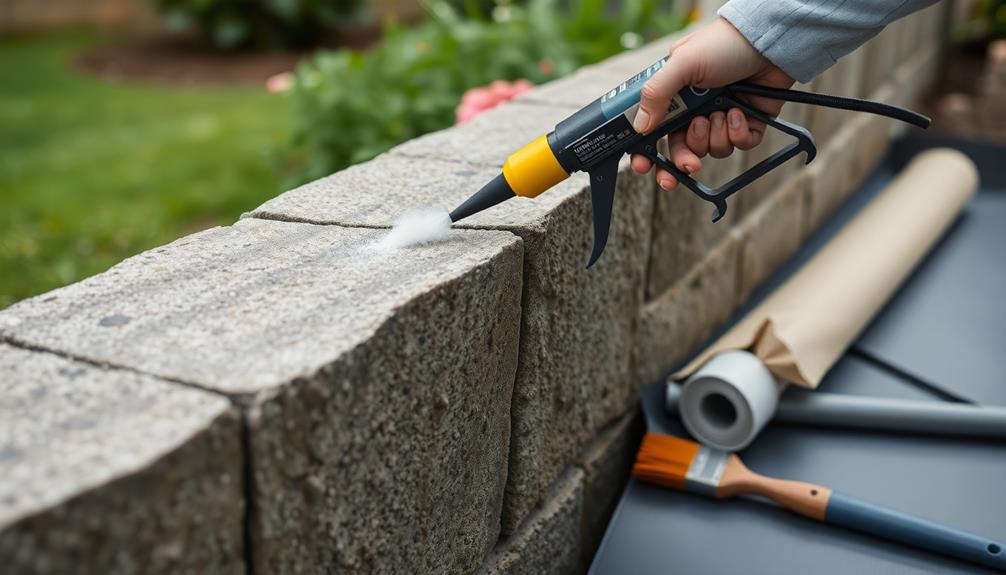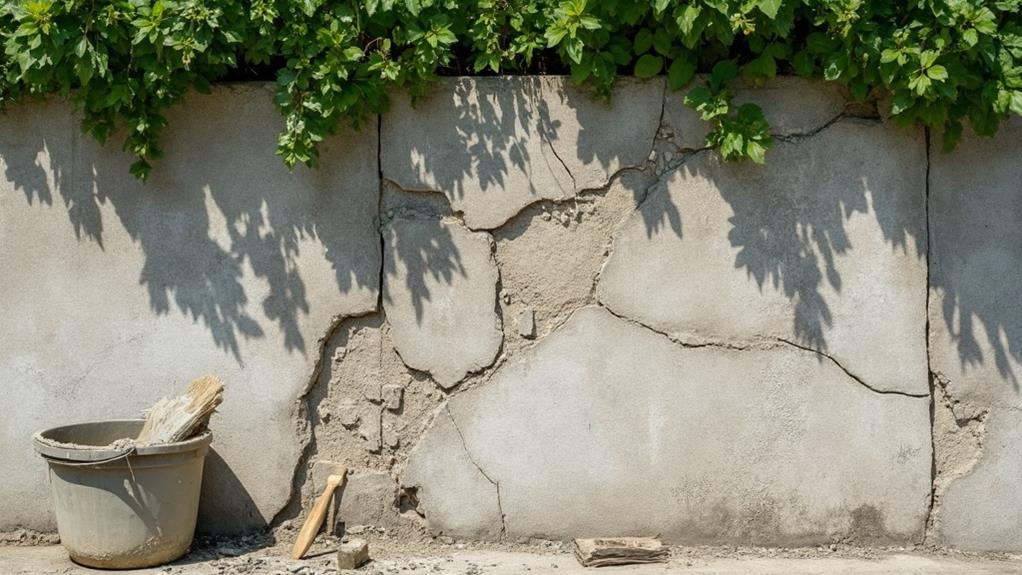Repairing cracks in retaining walls requires a thorough approach to guarantee structural integrity and longevity. Begin by evaluating the wall's load-bearing capacity and identifying weaknesses through visual inspections and non-destructive testing. Clean the cracked area thoroughly and apply appropriate sealants or epoxy injections, depending on the crack's size and depth. For larger fissures, consider using carbon fiber reinforcement or installing additional support systems. Improve drainage to prevent future water damage and reduce hydrostatic pressure. Regular maintenance, including the application of waterproof coatings and hydrophobic admixtures, can greatly extend the wall's lifespan. A deeper understanding of these techniques will provide invaluable insights for effective retaining wall repair.
Table of Contents
ToggleWalls Contractor Highlights
- Clean the crack thoroughly, removing debris and loose material to ensure proper repair adhesion.
- Apply a suitable concrete crack filler or epoxy injection for narrow cracks using a caulking gun.
- For wider cracks, use a patching compound or hydraulic cement, following manufacturer instructions for mixing and application.
- Install drainage improvements to prevent future water damage and reduce pressure on the repaired areas.
- Monitor the repaired cracks regularly and reapply sealant or filler as needed to maintain the wall's integrity.
Structural Integrity of Retaining Walls

The structural integrity of retaining walls hinges on three critical factors: load-bearing capacity assessment, identification of structural weaknesses, and consideration of long-term stability factors. Retaining wall contractors often provide valuable advice on the best designs and materials to enhance these aspects.
A thorough evaluation of a retaining wall's load-bearing capacity involves analyzing soil pressure, hydrostatic forces, and potential surcharge loads that may impact the wall's performance over time. Identifying structural weaknesses, such as inadequate reinforcement, poor drainage systems, or substandard materials, is essential for developing effective repair strategies.
Retaining walls built from a wide range of materials, such as boulder, fieldstone, or concrete, require specific approaches to certify sustained performance. Evaluating long-term stability factors—including soil erosion, freeze-thaw cycles, and vegetation growth—guarantees the wall's continued functionality and safety.
Load-Bearing Capacity Assessment
Evaluating the load-bearing capacity of a retaining wall is essential before attempting any repair work. This assessment involves a comprehensive analysis of the wall's structural integrity, considering factors such as soil conditions, hydrostatic pressure, and the weight of retained materials. Engineers utilize sophisticated methods, including finite element analysis and geotechnical investigations, to determine the wall's current load-bearing capabilities and identify potential weaknesses.
The assessment process typically begins with a thorough visual inspection, followed by non-destructive testing techniques such as ground-penetrating radar or ultrasonic pulse velocity testing. These methods allow professionals to detect internal structural issues without compromising the wall's integrity. Additionally, soil samples are collected and analyzed to evaluate the foundation's stability and potential for settlement.
Load-bearing capacity calculations take into account the wall's dimensions, material properties, and reinforcement systems, if present. The results of this assessment provide crucial information for developing an appropriate repair strategy, ensuring that any remediation efforts address not only visible cracks but also underlying structural deficiencies. By conducting a thorough load-bearing capacity assessment, property owners can safeguard their investments and guarantee the long-term stability of their retaining walls.
Identifying Structural Weaknesses
After conducting a thorough load-bearing capacity assessment, identifying specific structural weaknesses in retaining walls becomes essential for developing an effective repair strategy. This process involves a meticulous examination of the wall's components and surrounding environment to pinpoint areas of vulnerability.
Structural engineers and experienced contractors typically look for signs of deterioration, such as spalling concrete, exposed reinforcement, or visible cracks that may indicate underlying issues.
Key factors to examine include soil erosion behind the wall, inadequate drainage systems, and settlement of the foundation. These elements can contribute to increased pressure on the structure, potentially leading to failure if left unaddressed. Additionally, the assessment should encompass an evaluation of the wall's geometry, including its height, thickness, and reinforcement details, to determine if they meet current engineering standards.
Environmental factors like freeze-thaw cycles, vegetation growth, and water infiltration must also be taken into account, as they can exacerbate existing weaknesses. By systematically identifying these vulnerabilities, property owners and professionals can prioritize repairs and implement targeted solutions to enhance the retaining wall's longevity and structural integrity, ensuring the safety and stability of the surrounding landscape.
Long-Term Stability Factors
Ensuring long-term stability of retaining walls requires careful consideration of multiple factors that influence structural integrity over time. These factors encompass both environmental and design-related elements that collectively determine a wall's resilience against deterioration and failure.
Proper drainage systems, for instance, play an indispensable role in preventing hydrostatic pressure buildup behind the wall, which can lead to cracking and eventual collapse. The quality of backfill material and its compaction greatly impact the wall's ability to withstand lateral earth pressures.
Additionally, the wall's foundation depth and reinforcement methods, such as the use of geotextiles or tiebacks, contribute to its long-term stability. Climate considerations, including freeze-thaw cycles and temperature fluctuations, must be factored into the wall's design to prevent premature degradation.
Regular maintenance and inspections are essential for identifying early signs of distress and implementing timely repairs. By addressing these long-term stability factors during the initial design phase and throughout the wall's lifespan, property owners and engineers can ensure the retaining wall continues to function effectively, maintaining both its structural integrity and aesthetic appeal for years to come.
Benefits

Repairing cracks in retaining walls offers numerous advantages that extend beyond mere aesthetics. By addressing these issues promptly, property owners can drastically reduce long-term maintenance costs while simultaneously enhancing the structural integrity of their walls.
This process also prevents soil erosion, ensuring that the retaining wall holds ground effectively and maintains its functionality. Additionally, the restoration process not only improves the visual appeal of the property but also extends the lifespan of the retaining wall, ensuring its continued functionality for years to come.
Cost-Effective Property Maintenance
Numerous benefits arise from cost-effective property maintenance, particularly when addressing retaining wall cracks. By promptly repairing these structural issues, homeowners can prevent more extensive and costly damage in the future. This proactive approach not only preserves the integrity of the retaining wall but also safeguards the surrounding landscape and property value.
Implementing cost-effective maintenance strategies allows property owners to allocate resources efficiently, ensuring that small problems do not escalate into major renovations. Regular inspections and timely repairs of retaining walls contribute to the overall aesthetic appeal of the property, enhancing curb appeal and potentially increasing resale value. Additionally, this approach demonstrates responsible stewardship of one's investment, which can be particularly appealing to potential buyers or renters.
Improved Structural Integrity
One of the primary benefits of repairing cracks in retaining walls is the significant improvement in structural integrity. By addressing these issues promptly, property owners can guarantee the longevity and stability of their retaining walls, safeguarding their investments and enhancing the overall safety of their landscapes. When cracks are repaired, the wall's ability to withstand lateral earth pressure is restored, preventing potential soil erosion, water infiltration, and further damage to the structure.
The improved structural integrity resulting from crack repairs extends beyond the immediate benefits. It contributes to the preservation of surrounding structures and landscaping elements, maintaining the aesthetic appeal and functionality of the entire property. In addition, a well-maintained retaining wall with enhanced structural integrity provides peace of mind to property owners, knowing that their outdoor spaces are secure and reliable. This assurance is particularly valuable in areas prone to soil movement or extreme weather conditions, where the stability of retaining walls is essential for preventing more extensive damage to the property. By investing in proper crack repairs, property owners demonstrate their commitment to maintaining a safe and resilient environment for themselves and their community.
Enhanced Aesthetic Appeal
Beyond structural benefits, how does addressing cracks in retaining walls enhance the overall appearance of a property? Repairing these imperfections drastically improves the visual appeal of your outdoor space, contributing to a well-maintained and attractive landscape.
A crack-free retaining wall presents a uniform, polished appearance that complements the surrounding environment and increases curb appeal. This aesthetic enhancement can potentially increase property value and create a more inviting atmosphere for both residents and visitors.
The visual improvements resulting from crack repair include:
- Restoration of the wall's original color and texture
- Elimination of unsightly fissures and gaps
- Prevention of further deterioration and staining
- Seamless integration with existing landscaping elements
Increased Wall Longevity
Repairing cracks in retaining walls significantly extends their lifespan, ensuring long-term stability and functionality. By addressing structural issues promptly, homeowners and property managers can prevent further deterioration and costly replacements. The process of crack repair not only reinforces the wall's integrity but also mitigates potential risks associated with water infiltration and soil erosion.
When cracks are properly sealed and reinforced, the wall's resistance to environmental stressors greatly improves. This enhanced durability translates to reduced maintenance requirements over time, allowing property owners to allocate resources more efficiently. Additionally, the repaired wall's improved structural integrity enables it to better withstand dynamic loads, such as soil pressure and hydrostatic forces, which are common culprits in wall failure.
The longevity benefits extend beyond the wall itself, positively impacting the surrounding landscape and adjacent structures. A well-maintained retaining wall continues to effectively manage soil retention, prevent erosion, and maintain proper drainage patterns for years to come. This proactive approach to wall repair fosters a sense of security and responsible property management within the community, aligning with the values of conscientious homeowners and property stewards.
Waterproofing Techniques for Longevity

Waterproofing techniques play a pivotal role in extending the lifespan of repaired retaining walls by preventing moisture infiltration and subsequent damage. Implementing a combination of sealants, waterproof coatings, drainage system improvements, and hydrophobic admixtures can substantially enhance the wall's resistance to water-related deterioration. The following table outlines key waterproofing methods and their specific benefits for retaining wall longevity:
| Technique | Benefits |
|---|---|
| Sealants and Waterproof Coatings | Creates a protective barrier against moisture penetration |
| Drainage System Improvements | Reduces hydrostatic pressure and prevents water accumulation |
| Hydrophobic Admixtures | Enhances concrete's water-repelling properties from within |
| Regular Maintenance | Guarantees ongoing effectiveness of waterproofing measures |
Sealants and Waterproof Coatings
Sealants and waterproof coatings play an essential role in protecting repaired retaining walls from future water damage. These protective layers act as a barrier against moisture infiltration, preserving the integrity of the wall and extending its lifespan. When selecting an appropriate sealant or coating, consider factors such as the wall material, climate conditions, and the severity of water exposure. High-quality products specifically designed for retaining walls offer superior protection and durability.
To guarantee optimal results, follow these key steps when applying sealants and waterproof coatings:
- Thoroughly clean and prepare the wall surface
- Address any existing cracks or damage before application
- Apply the product evenly and according to manufacturer instructions
- Allow sufficient drying time between coats
Frequent maintenance and reapplication of sealants and coatings are crucial for long-term protection. Inspect the wall annually for signs of wear or damage, and reapply the protective layer as needed. By implementing these preventive measures, you can drastically reduce the risk of water-related issues and maintain the structural integrity of your retaining wall. Remember, investing in quality sealants and waterproof coatings is a cost-effective strategy for preserving your property's value and ensuring the longevity of your retaining wall.
Drainage System Improvements
While sealants and coatings provide surface-level protection, a robust drainage system is fundamental for long-term retaining wall stability. Improving the existing drainage infrastructure can greatly reduce hydrostatic pressure, which is often the root cause of cracks and structural damage. Begin by inspecting the current system, identifying any clogged or damaged components that may be hindering proper water diversion.
To enhance drainage efficiency, consider installing additional weep holes at regular intervals along the wall's base. These small openings allow water to escape, preventing buildup behind the structure. Implement an all-encompassing French drain system, consisting of perforated pipes surrounded by gravel, to channel water away from the wall's foundation. This method effectively manages subsurface water, reducing the risk of soil erosion and subsequent wall movement.
For maximum performance, integrate a geotextile filter fabric between the soil and drainage material. This barrier prevents fine soil particles from clogging the system while allowing water to pass through freely. Regular maintenance of the improved drainage system, including periodic cleaning and inspection, ensures its continued effectiveness in protecting your retaining wall from moisture-related damage and preserving its structural integrity for years to come.
Hydrophobic Admixtures Application
To further enhance the longevity of repaired retaining walls, the application of hydrophobic admixtures offers a powerful waterproofing solution. These innovative compounds, when integrated into the repair materials or applied as a surface treatment, create a water-repellent barrier that considerably reduces moisture penetration. This advanced technique not only protects against future water damage but also enhances the overall durability of the structure.
The application of hydrophobic admixtures involves several key steps:
- Thorough cleaning and preparation of the wall surface
- Selection of an appropriate hydrophobic admixture compatible with the existing materials
- Precise mixing and application according to manufacturer specifications
- Curing and protection of the treated area during the initial setting period
Walls Contractor FAQ
Can I Paint Over Repaired Cracks in My Retaining Wall?
Painting over repaired cracks in your retaining wall is possible and often recommended. It helps protect the repairs, enhances aesthetics, and creates a unified look. Guarantee the repairs are fully cured before applying paint for best results.
How Often Should I Inspect My Retaining Wall for Cracks?
Regularly inspecting your retaining wall is essential for maintaining its integrity. We recommend conducting thorough examinations at least twice a year, typically in spring and fall. Additionally, perform checks after severe weather events or significant ground disturbances to guarantee continued stability.
Are There Any Eco-Friendly Options for Repairing Retaining Wall Cracks?
Yes, eco-friendly options for repairing retaining wall cracks exist. Consider using sustainable materials like hemp-based sealants, recycled aggregates, or bio-based epoxies. These environmentally conscious choices allow us to maintain our structures while minimizing our ecological footprint as a community.
What Tools Are Essential for DIY Retaining Wall Crack Repairs?
Fellow DIY enthusiasts, for retaining wall crack repairs, you'll need these essential tools: safety gear, wire brush, chisel, hammer, pressure washer, caulking gun, trowel, and mixing bucket. Don't forget crack filler, epoxy, or mortar mix, depending on the repair method.
Can Plants or Vegetation Contribute to Cracking in Retaining Walls?
Yes, plants and vegetation can contribute extensively to retaining wall cracks. Root systems can exert pressure, causing structural damage. Additionally, moisture retention from nearby plants can lead to soil expansion and contraction, further stressing the wall over time.







